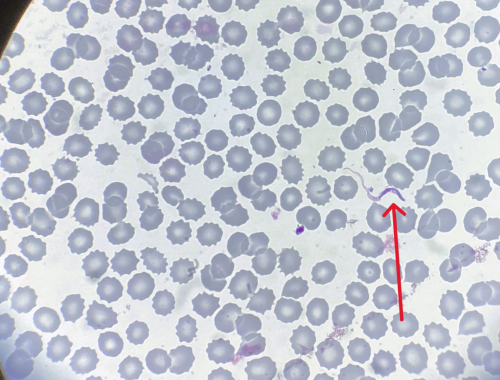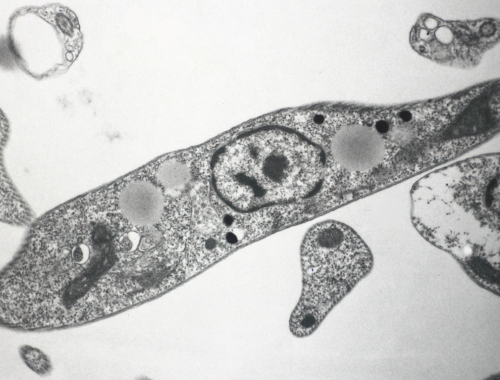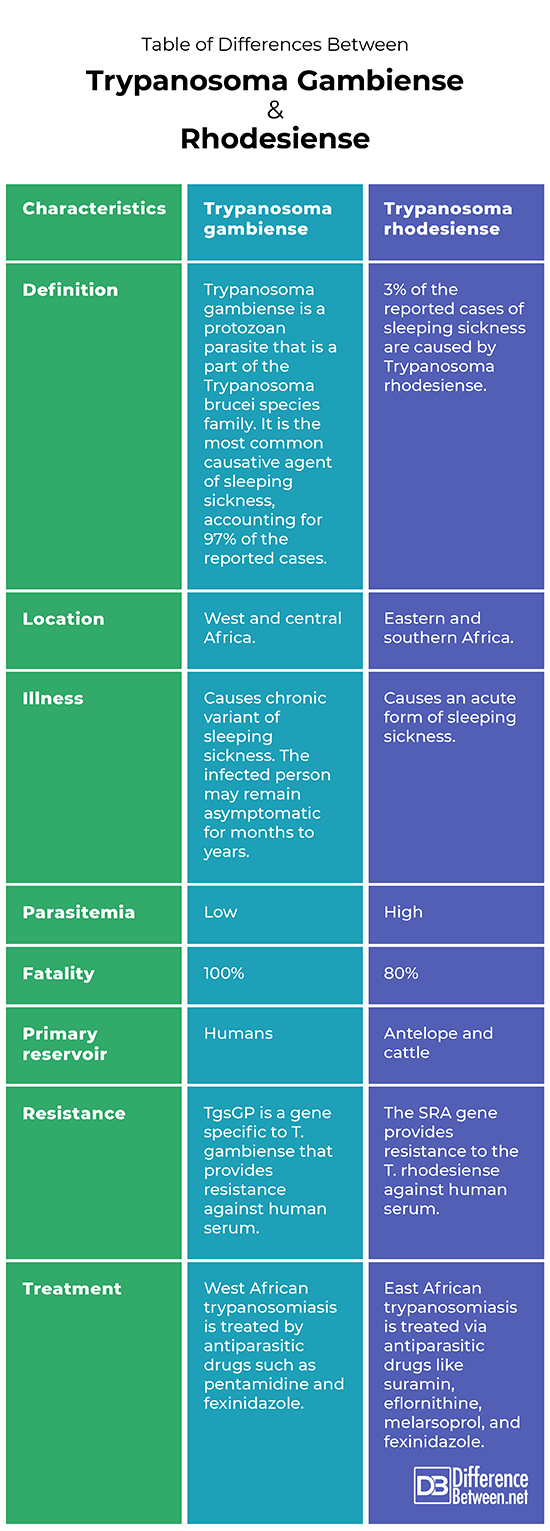Difference Between Trypanosoma Gambiense and Rhodesiense
Trypanosoma gambiense is a protozoan parasite that is a part of the Trypanosoma brucei species family. It is the most common causative agent of sleeping sickness, accounting for 97% of the reported cases. 3% of the reported cases of sleeping sickness are caused by Trypanosoma rhodesiense.

What is Trypanosoma gambiense?
Definition:
Trypanosoma gambiense is a protozoan parasite that is a part of the Trypanosoma brucei species family. It is the most common causative agent of sleeping sickness, accounting for 97% of the reported cases.
Location:
The organism is found predominantly in west and central Africa. It is spread in 24 African countries over the Western belt.
Illness:
Trypanosoma gambiense causes a chronic variant of sleeping sickness. The infected person may remain asymptomatic for months to years. At the time of presentation, the central nervous system of the patient is already severely and irreversibly damaged. The parasitemia is low in West African trypanosomiasis. Also, the fatality rate of the disease is almost 100%.
Vector:
The vector of T. gambiense is the Tsetse fly (palpalis group).
Reservoir:
Humans are the key reservoir of T. gambiense.
Epidemiology:
West African trypanosomiasis is frequent in the rural population.
Resistance:
TgsGP is a gene specific to T. gambiense that provides resistance against human serum.
Treatment:
West African trypanosomiasis is treated by antiparasitic drugs such as pentamidine and fexinidazole.

What is Trypanosoma rhodesiense?
Definition:
Trypanosoma rhodesiense is a protozoan parasite that is a part of the Trypanosoma brucei species complex. 3% of the reported cases of sleeping sickness are caused by Trypanosoma rhodesiense.
Location:
The organism is found readily in Eastern and southern Africa.
Illness:
Trypanosoma rhodesiense causes an acute form of sleeping sickness. Symptoms appear within weeks and months of the infection. The organism is fast spreading and the parasitemia is high in East African trypanosomiasis. The fatality rate of the infection is 80%.
Vector:
The vector of T. rhodesiense is the Tsetse fly (morsitans group).
Reservoir:
Antelope and cattle are the primary reservoirs of T. rhodesiense.
Epidemiology:
East African trypanosomiasis is frequent in the rural population, tourists visiting game parks, and workers in wild areas.
Resistance:
The SRA gene provides resistance to the T. rhodesiense against human serum.
Treatment:
East African trypanosomiasis is treated via antiparasitic drugs like suramin, eflornithine, melarsoprol, and fexinidazole.
Difference between Trypanosoma gambiense and rhodesiense
Definition:
Trypanosoma gambiense is a protozoan parasite that is a part of the Trypanosoma brucei species family. It is the most common causative agent of sleeping sickness, accounting for 97% of the reported cases. Trypanosoma rhodesiense is a protozoan parasite that is a part of the Trypanosoma brucei species complex. 3% of the reported cases of sleeping sickness are caused by Trypanosoma rhodesiense.
Location:
T. gambiense is found predominantly in west and central Africa. It is spread in 24 African countries over the Western belt. T. rhodesiense is found readily in Eastern and southern Africa.
Illness:
Trypanosoma gambiense causes a chronic variant of sleeping sickness. The infected person may remain asymptomatic for months to years. At the time of presentation, the central nervous system of the patient is already severely and irreversibly damaged. The parasitemia is low in West African trypanosomiasis. Also, the fatality rate of the disease is almost 100%. Trypanosoma rhodesiense causes an acute form of sleeping sickness. Symptoms appear within weeks and months of the infection. The organism is fast spreading and the parasitemia is high in East African trypanosomiasis. The fatality rate of the infection is 80%.
Vector:
The vector of T. gambiense is the Tsetse fly (palpalis group). The vector of T. rhodesiense is the Tsetse fly (morsitans group).
Reservoir:
Humans are the key reservoir of T. gambiense whereas antelope and cattle are the primary reservoirs of T. rhodesiense.
Epidemiology:
West African trypanosomiasis is frequent in the rural population. East African trypanosomiasis is frequent in the rural population, tourists visiting game parks, and workers in wild areas.
Resistance:
TgsGP is a gene specific to T. gambiense that provides resistance against human serum. The SRA gene provides resistance to the T. rhodesiense against human serum.
Treatment:
West African trypanosomiasis is treated by antiparasitic drugs such as pentamidine and fexinidazole. East African trypanosomiasis is treated via antiparasitic drugs like suramin, eflornithine, melarsoprol, and fexinidazole.
Table of difference between Trypanosoma gambiense and rhodesiense

FAQs:
What is the difference between T gambiense and T. b. rhodesiense?
Trypanosoma gambiense is a protozoan parasite that is the most common causative agent of sleeping sickness, accounting for 97% of the reported cases. 3% of the reported cases of sleeping sickness are caused by Trypanosoma rhodesiense.
What is the difference between the two types of trypanosomiasis?
T. gambiense causes 97% of sleeping sickness cases whereas T. rhodesiense causes 3% of sleeping sickness cases.
What is the infective stage of Trypanosoma brucei gambiense and Rhodesiense?
The infective stage of Trypanosoma gambiense and rhodesiense is metacyclic trypomastigote.
What is Trypanosoma rhodesiense disease?
It is an acute sleeping sickness, also known as East African trypanosomiasis.
What are the three types of trypanosomiasis?
The three types of trypanosomiasis are: American trypanosomiasis also called Chagas disease, East African sleeping sickness, and West African sleeping sickness.
What are the three species of trypanosomiasis?
Trypanosoma brucei, T. evansi and T. equiperdum.
- Difference Between Fear and Anxiety - April 2, 2024
- Difference Between Climate Change and Global Warming - April 2, 2024
- Difference Between CT Scan and MRI Scan - February 18, 2024
Search DifferenceBetween.net :
Leave a Response
References :
[0]Büscher, Philippe, et al. "Human african trypanosomiasis." The Lancet 390.10110 (2017): 2397-2409.
[1]Brun, Reto, et al. "Human african trypanosomiasis." The Lancet 375.9709 (2010): 148-159.
[2]Steverding, Dietmar. "The history of African trypanosomiasis." Parasites & vectors 1.1 (2008): 1-8.
